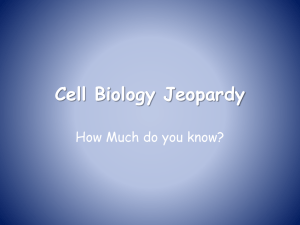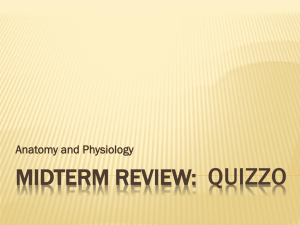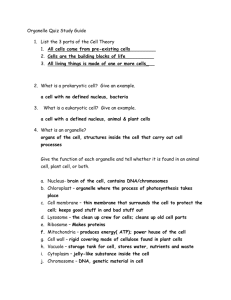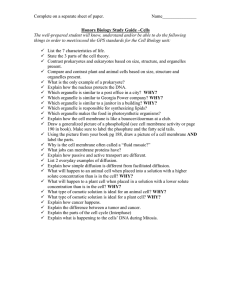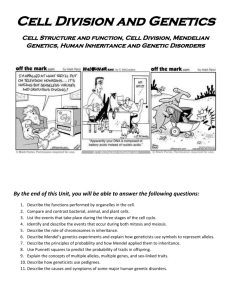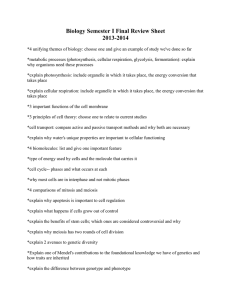Module 4 - Weber State University
advertisement
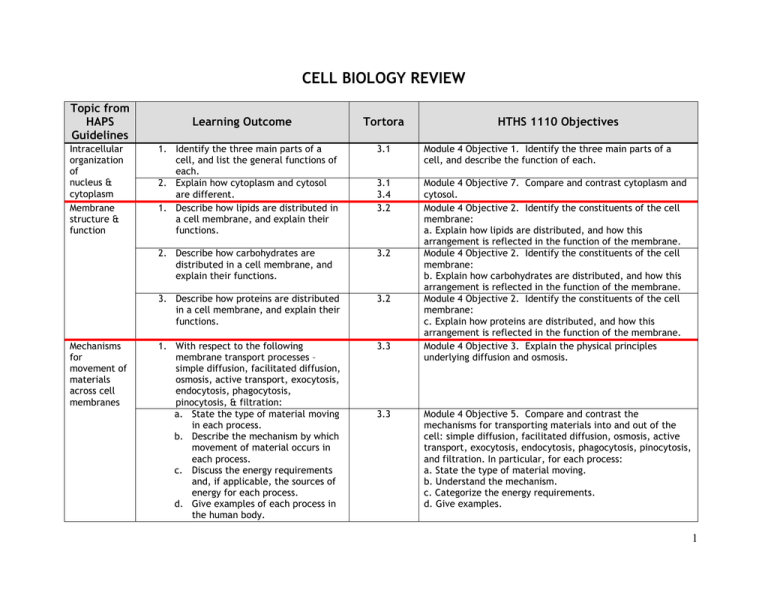
CELL BIOLOGY REVIEW Topic from HAPS Guidelines Intracellular organization of nucleus & cytoplasm Membrane structure & function Mechanisms for movement of materials across cell membranes Learning Outcome Tortora HTHS 1110 Objectives 1. Identify the three main parts of a cell, and list the general functions of each. 2. Explain how cytoplasm and cytosol are different. 1. Describe how lipids are distributed in a cell membrane, and explain their functions. 3.1 Module 4 Objective 1. Identify the three main parts of a cell, and describe the function of each. 3.1 3.4 3.2 2. Describe how carbohydrates are distributed in a cell membrane, and explain their functions. 3.2 3. Describe how proteins are distributed in a cell membrane, and explain their functions. 3.2 1. With respect to the following membrane transport processes – simple diffusion, facilitated diffusion, osmosis, active transport, exocytosis, endocytosis, phagocytosis, pinocytosis, & filtration: a. State the type of material moving in each process. b. Describe the mechanism by which movement of material occurs in each process. c. Discuss the energy requirements and, if applicable, the sources of energy for each process. d. Give examples of each process in the human body. 3.3 Module 4 Objective 7. Compare and contrast cytoplasm and cytosol. Module 4 Objective 2. Identify the constituents of the cell membrane: a. Explain how lipids are distributed, and how this arrangement is reflected in the function of the membrane. Module 4 Objective 2. Identify the constituents of the cell membrane: b. Explain how carbohydrates are distributed, and how this arrangement is reflected in the function of the membrane. Module 4 Objective 2. Identify the constituents of the cell membrane: c. Explain how proteins are distributed, and how this arrangement is reflected in the function of the membrane. Module 4 Objective 3. Explain the physical principles underlying diffusion and osmosis. 3.3 Module 4 Objective 5. Compare and contrast the mechanisms for transporting materials into and out of the cell: simple diffusion, facilitated diffusion, osmosis, active transport, exocytosis, endocytosis, phagocytosis, pinocytosis, and filtration. In particular, for each process: a. State the type of material moving. b. Understand the mechanism. c. Categorize the energy requirements. d. Give examples. 1 2. Describe the effects of hypertonic, isotonic, and hypotonic conditions on cells. 3. Demonstrate various cell transport processes and, given appropriate information, predict the outcomes of these demonstrations. Organelles Protein synthesis 3.3 Module 4 Objective 4. Describe the effects of changing tonicity on cells. Module 4 Objective 6. Be able to diagram and discuss each of the cell transport processes. 1. Define the term organelle. 3.4 Module 4 Objective 8. Define “organelle”. 2. For each different type of organelle associated with human cells: a. Identify the organelle. b. Describe the structure of the organelle. c. Describe the function of the organelle. 3.4 Module 4 Objective 8. Define “organelle”. For each of the following organelles, describe its structure and function and be able to recognize it in either a diagram or electron micrograph. 3.4 3.4 3.4 3.5 a. Structural integrity 1. Cytoskeleton 2. Centrosome b. Motility 1. Cilia 2. Flagella c. Synthesis 1. Ribosome 2. Rough endoplasmic reticulum 3. Smooth endoplasmic reticulum 4. Golgi complex d. Storage and digestion 1. Smooth endoplasmic reticulum 2. Lysosome 3. Peroxisome 4. Proteasome e. Energy production 1. Mitochondrion 1. Define the terms genetic code, transcription and translation. 3.6 2. Explain how and why RNA is synthesized. 3.6 Module 5 Objective 1. Define the following terms: a. genetic code b. transcription c. translation Module 5 Objective 2. Explain the role of RNA in the cell. 2 3. Explain the roles of tRNA, mRNA, and rRNA in protein synthesis. 3.6 Module 5 Objective 3. Summarize the roles of tRNA, mRNA and rRNA in protein synthesis. 1. Define the term cellular respiration. 25.1 Module 4 Objective 10. Define “cellular respiration” and the role of mitochondria in the cell. 2. With respect to glycolysis, the Krebs (citric acid or TCA) cycle, and the electron transport chain: compare and contrast energy input, efficiency of energy production, oxygen use, byproducts and cellular location. 1. Referring to a generalized cell cycle, including interphase and the stages of mitosis: 25.1 25.3 Module 4 Objective 9. Explain glycolysis, the Krebs cycle, and the electron transport chain. Compare and contrast each with respect to energy use, efficiency of energy production, use of oxygen, by-products, and cellular location. a. Describe the events that take place in each stage. b. Identify cells that are in each stage. c. Analyze the functional significance of each stage. Distinguish between mitosis and cytokinesis. Describe DNA replication. Analyze the interrelationships among chromatin, chromosomes and chromatids. Give examples of cell types in the body that divide by mitosis and examples of circumstances in the body that require mitotic cell division. Describe the events that take place in each stage of meiosis I and meiosis II. Identify cells that are in each stage of meiosis I and meiosis II. Compare and contrast the general features of meiosis I and meiosis II. 3.7 Cellular respiration (introduction) Somatic cell division 2. 3. 4. 5. Reproductive cell division 1. 2. 3. Module 5 Objective 4. Understand the cell cycle. Describe the events that take place in each stage. Be able to recognize each stage in diagrams or photographs. Know the functional significance of each stage. 3.7 3.7 Module 5 Objective 4. Understand the cell cycle. Describe the events that take place in each stage. Be able to recognize each stage in diagrams or photographs. Know the functional significance of each stage. 3.7 3.7 3.7 3.7 3.7 3 Application of homeostatic mechanisms Predictions related to homeostatic imbalance, including disease states & disorders 4. Compare and contrast the processes of mitosis and meiosis. 5. Give examples of cell types in the body that divide by meiosis and examples of circumstances in the body that require meiotic cell division. 1. Provide specific examples to demonstrate how individual cells respond to their environment (e.g., in terms of organelle function, transport processes, protein synthesis, or regulation of cell cycle) in order to maintain homeostasis in the body. 1. Predict factors or situations that could disrupt organelle function, transport processes, protein synthesis, or the cell cycle. 2. Predict the types of problems that would occur if the cells could not maintain homeostasis due to abnormalities in organelle function, transport processes, protein synthesis, or the cell cycle. 3.7 28.1 28.2 4
